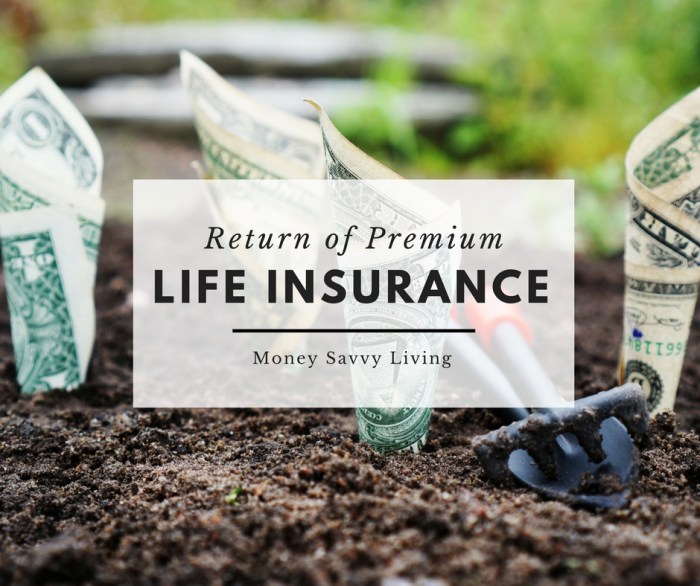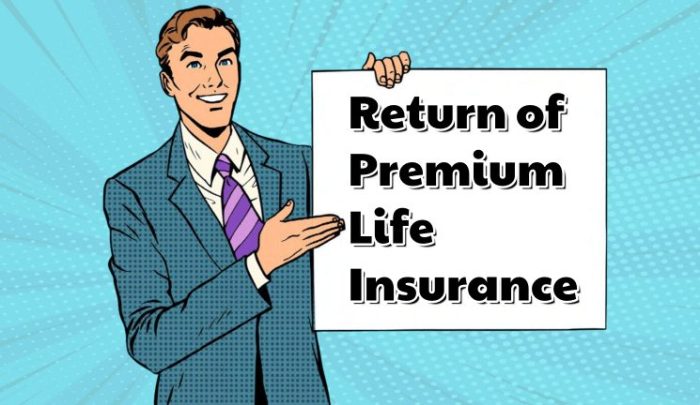Life insurance is a cornerstone of financial planning, offering crucial protection for loved ones. However, the traditional model often leaves policyholders with no financial return if they outlive the policy term. Enter Return of Premium (ROP) life insurance, a unique approach that offers a compelling blend of life insurance coverage and the potential for a full premium refund. This guide delves into the intricacies of ROP policies, exploring their benefits, costs, and suitability for various financial situations.
We will dissect the mechanics of ROP life insurance, comparing it to traditional term and whole life policies. Understanding the nuances of premium costs, tax implications, and return on investment (ROI) is vital for making informed decisions. We’ll explore real-world scenarios and provide practical advice to help you determine if an ROP policy aligns with your personal financial goals and risk tolerance.
Defining Return of Premium Life Insurance

Return of Premium (ROP) life insurance is a type of life insurance policy that offers a unique benefit: the return of your premiums if you outlive the policy term. It combines the death benefit of traditional life insurance with a savings component, providing a financial safety net and a potential refund of all premiums paid. This makes it an attractive option for those seeking both life insurance coverage and a potential return on their investment.
Return of premium life insurance policies typically refund all premiums paid if the insured survives the policy term. This return is usually paid as a lump sum at the end of the policy term. However, it’s crucial to understand that the specific conditions for premium return can vary significantly between insurers and policy types. Some policies may have stipulations, such as requiring the policy to remain in force for the entire term without lapses, or may only return a portion of the premiums paid under certain circumstances. Carefully reviewing the policy documents is essential before purchasing.
Types of Return of Premium Policies
Several variations of ROP policies exist, each with its own set of features and conditions. These differences can impact the overall cost and the amount of premium returned.
For instance, some policies might offer a level premium throughout the policy term, while others may have premiums that adjust over time. Similarly, the amount of the death benefit can vary, with some policies offering a higher death benefit in exchange for higher premiums, and others providing a lower death benefit with correspondingly lower premiums. Some policies may also incorporate other features, such as accelerated death benefits or cash value accumulation options, which can influence the overall cost and benefits.
Return of Premium vs. Traditional Term Life Insurance
ROP policies differ significantly from traditional term life insurance. Traditional term life insurance provides a death benefit for a specified period (the term), but premiums are not returned if the insured survives the term. ROP policies, on the other hand, provide the death benefit plus a guaranteed return of premiums if the insured survives the policy term. This added benefit comes at a higher premium cost compared to a traditional term life insurance policy with the same death benefit and term length. The decision of whether to choose ROP or traditional term life insurance depends on individual financial goals and risk tolerance. A person prioritizing a guaranteed return of premiums might prefer ROP, while someone focused solely on securing a death benefit at the lowest cost might opt for traditional term life insurance.
Financial Aspects of Return of Premium Policies

Return of premium (ROP) life insurance policies offer a unique blend of life insurance coverage and a potential financial return. Understanding the financial implications, however, is crucial before committing to such a policy. This section delves into the cost structure, tax considerations, and long-term cost-effectiveness of ROP policies compared to traditional term or whole life insurance.
Premium Costs of Return of Premium Policies
ROP policies typically come with higher premiums than comparable traditional term life insurance policies. This is because the insurer must account for the guaranteed return of premiums at the end of the policy term. The premium increase reflects the added cost of the return-of-premium feature. The exact premium will depend on factors such as age, health, coverage amount, and the length of the policy term. It’s essential to compare the premium costs of ROP policies with those of traditional policies offering similar coverage to make an informed decision. For example, a 20-year, $500,000 ROP policy might cost significantly more annually than a similar traditional term policy, but this difference is offset by the eventual premium refund.
Tax Implications of Premium Refunds
The tax implications of receiving a premium refund from a ROP policy can vary depending on jurisdiction and specific policy details. Generally, the returned premiums are considered taxable income in the year they are received. This means you’ll need to report the refund on your tax return and pay taxes on it at your ordinary income tax rate. It’s advisable to consult with a tax professional to fully understand the tax implications specific to your situation and policy. Careful planning can help mitigate the tax burden associated with the return of premiums.
Long-Term Cost-Effectiveness Compared to Traditional Policies
Determining the long-term cost-effectiveness of a ROP policy versus a traditional policy requires a careful comparison. While ROP policies have higher premiums, they offer a guaranteed return of premiums, effectively making them a form of investment. Traditional term life insurance, however, is significantly cheaper in the short term, but offers no return of premiums upon expiry.
Let’s consider an example: Suppose a 40-year-old purchases a $500,000, 20-year term life insurance policy. A traditional policy might cost $1,000 annually, totaling $20,000 over 20 years. A comparable ROP policy might cost $1,500 annually, totaling $30,000 over 20 years. At the end of 20 years, the ROP policy returns $30,000, effectively negating the extra premium paid. The traditional policy offers no such return. The choice depends on individual financial goals and risk tolerance. If the individual values the guaranteed return, the higher premium of the ROP policy might be justified.
Return on Investment (ROI) of Return of Premium Policies
The following table compares the ROI of various hypothetical ROP policies over different time horizons. Note that these are simplified examples and actual ROI can vary based on several factors, including policy specifics and individual circumstances. These figures do not account for potential tax implications on the returned premiums.
| Policy Type | Premium Cost | Return Amount | ROI |
|---|---|---|---|
| ROP Policy A (10-year, $250,000) | $15,000 | $15,000 | 0% |
| ROP Policy B (20-year, $500,000) | $30,000 | $30,000 | 0% |
| ROP Policy C (30-year, $750,000) | $50,000 | $50,000 | 0% |
Understanding Policy Features and Benefits
Return of premium (ROP) life insurance offers a unique blend of life insurance coverage and a savings component. Understanding its features and benefits is crucial to determining if it aligns with your individual financial goals. This section will delve into the specifics of ROP policies, comparing them to other life insurance options.
Key Features and Benefits of Return of Premium Life Insurance
ROP life insurance policies provide a death benefit, much like traditional term or whole life insurance. However, the defining feature is the return of premiums paid over the policy’s term, provided the insured remains alive. This means that if you outlive the policy term, you receive a refund of all premiums paid, effectively turning the policy into a form of long-term savings vehicle with a built-in life insurance safety net. Other potential benefits can include the ability to add riders for additional coverage, such as accidental death benefits or critical illness coverage. The specific riders available will vary depending on the insurer and policy.
Coverage Provided and Limitations
The coverage provided by a ROP policy is primarily the death benefit payable to your beneficiaries should you pass away during the policy term. The amount of the death benefit is typically a fixed amount stated in the policy. Limitations and exclusions often mirror those found in standard life insurance policies. These may include exclusions for death caused by pre-existing conditions (depending on the policy and underwriting process), suicide during the early years of the policy, or death resulting from certain high-risk activities. It’s vital to carefully review the policy documents to understand the specific limitations and exclusions applicable to your policy. The return of premiums is also subject to certain conditions; for example, the full return might not be available if the policy is surrendered early or if specific policy conditions are not met.
Comparison with Other Life Insurance Products
Compared to term life insurance, ROP policies offer the added benefit of premium return, but typically come with higher premiums. Term life insurance provides coverage for a specified period (the term) at a lower cost, but offers no return of premiums. Whole life insurance offers lifelong coverage and a cash value component that grows over time, but premiums are typically higher than ROP policies, and the cash value growth may not match the premium payments. Universal life insurance offers flexibility in premium payments and death benefit amounts, but the return of premiums feature is generally not included. The best choice depends on individual needs and financial priorities.
Advantages and Disadvantages of Return of Premium Life Insurance
The decision to purchase ROP life insurance involves weighing its advantages and disadvantages carefully.
Understanding these points is crucial for making an informed decision.
- Advantages:
- Guaranteed return of premiums if the insured survives the policy term.
- Provides life insurance coverage for a specified period.
- May offer additional riders for expanded coverage.
- Disadvantages:
- Higher premiums compared to term life insurance.
- May not be as cost-effective as other life insurance options if the insured dies during the policy term.
- Potential limitations and exclusions may apply.
Ultimate Conclusion

Return of Premium life insurance presents a compelling alternative to traditional life insurance, offering a unique combination of protection and potential financial return. While the higher premiums are a consideration, the possibility of receiving all premiums back if you remain healthy throughout the policy term makes it an attractive option for certain individuals. Careful consideration of your personal circumstances, financial goals, and risk tolerance is crucial in determining whether an ROP policy is the right fit for your needs. By weighing the advantages and disadvantages Artikeld in this guide, you can make a well-informed decision that aligns with your long-term financial security.
Quick FAQs
What happens if I die during the policy term of a Return of Premium policy?
Your beneficiaries will receive the death benefit, as with any life insurance policy. The return of premiums is only applicable if you survive the policy term.
Are there any health requirements to qualify for a Return of Premium policy?
Yes, insurers will assess your health status through medical underwriting, similar to traditional life insurance. Your health and age will influence both eligibility and premium costs.
Can I withdraw any of the accumulated premiums before the policy term ends?
Generally, no. The return of premium is a feature tied to the policy’s maturity, and early withdrawals are typically not permitted.
How does the tax treatment of the returned premiums work?
This varies by jurisdiction, but generally, the returned premiums are considered a return of capital and are not usually subject to income tax. However, it is crucial to consult a tax professional for personalized advice.